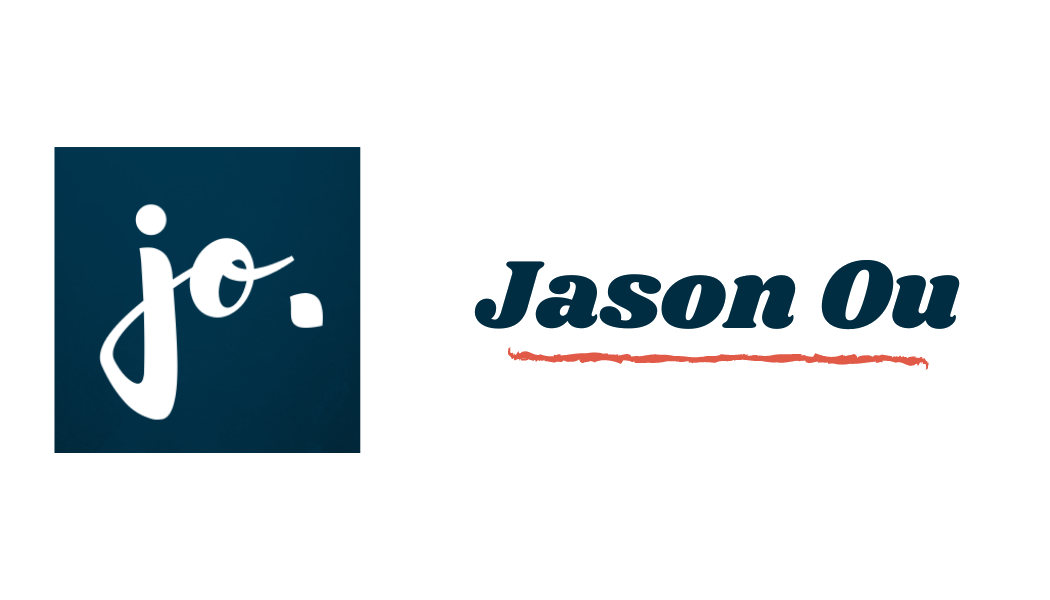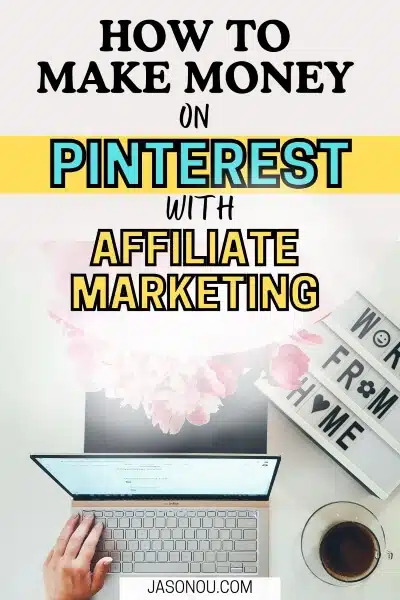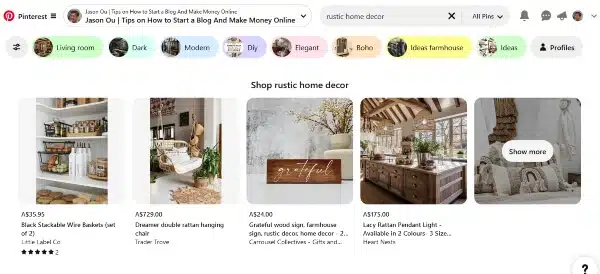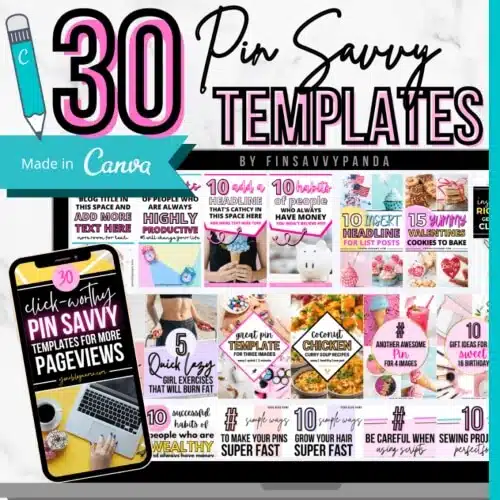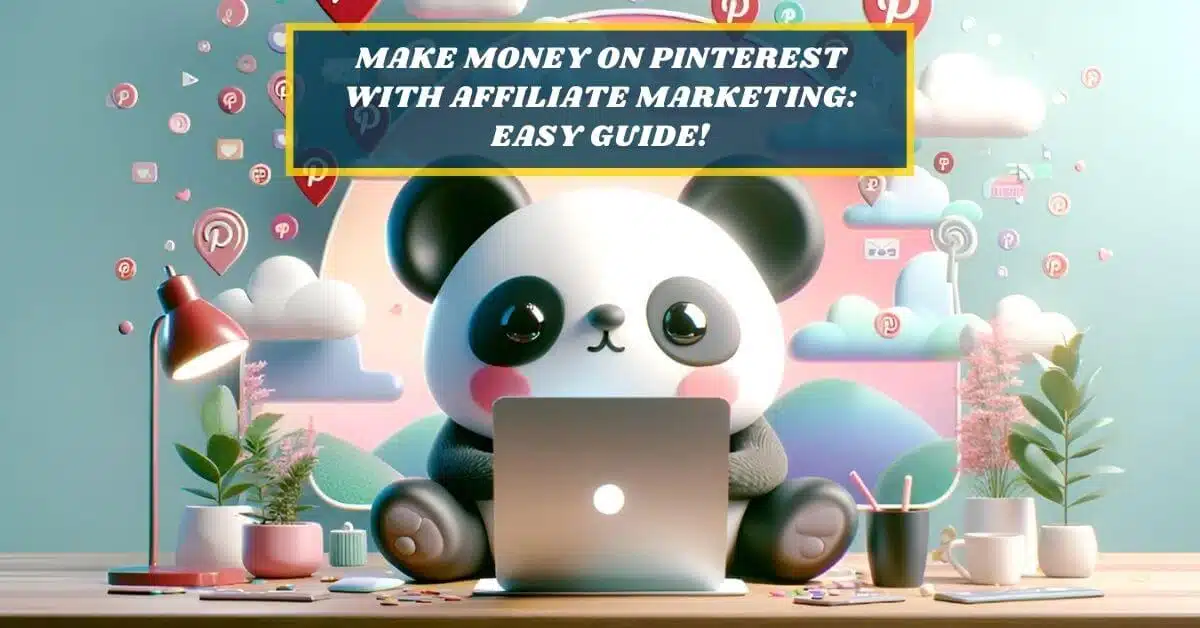Are you curious about how to make money on Pinterest with affiliate marketing?
With 498 million users around the world and 90.1 million from America, this platform is buzzing with potential.
It’s not just about pinning your favorite recipes anymore.
Pinterest is goldmine for those looking to earn online.
In this guide, you’ll learn how to make eye-catching pins and get tips for optimizing Pinterest affiliate marketing
You’ll also find out two ways to add affiliate links to your pins.
So, let’s see how to use Pinterest for Affiliate Marketing!
Ready to Learn How to Make Money on Pinterest With Affilate Marketing? Skip the Intro & Jump to Step 1 Here
Key Takeaways
- You can make money on Pinterest with affiliate marketing by creating helpful content on your blog and sprinkle in affiliate links within your posts. If someone buys a product through your link, you earn a commission.
- Keyword research plays a critical role in Pinterest affiliate marketing.
- Apply the best practices for Pinterest affiliate marketing by optimizing your profile, pin title, pin description, board title and board descriptions.
- Always use high-quality images and engaging content to catch people’s attention.
- Choosing the right products is key to success in Pinterest affiliate marketing. Pick items that match your niche and are appealing to your target audience. Use tools like Canva to create attractive pins.
- It’s important to follow Pinterest’s guidelines when using affiliate links, including adding proper disclosures. This keeps your account in good standing and builds trust with your followers.
- Growing traffic and income involves optimizing your Pinterest account, joining suitable affiliate programs, creating eye-catching pins, and promoting blog content on Pinterest effectively.
What is Pinterest Affiliate Marketing?
Save/Pin the image below👇because I often update my posts. So stay informed with this blog “How to Make Money on Pinterest With Affiliate Marketing” and save it.
Before I go on, read this.
Pinterest is a visual search engine.
Pinterest isn’t for hanging out and chatting like other social media. It’s more like Google, but with pictures.
Folks on Pinterest aren’t there to chat or give thumbs-up to selfies.
They’re hunting for cool ideas, tips, or some inspiration.
Here’s where lots of bloggers mess up:
They treat Pinterest like it’s Facebook or Instagram, expecting likes and comments.
But when they don’t get the buzz they hoped for, they get bummed out and stop using Pinterest.
And guess what? That’s good news for you!
That said.
Pinterest is like a giant digital bulletin board where folks can find and share cool ideas, things they want to buy, and all sorts of inspiration.
When you share something, you pin a picture that links to more info.
You can also organize these pins on boards, kind of like creating a themed collection or a dream board.
Now, when we talk about making money on Pinterest through affiliate marketing, it means you share pins with special links to products or services.
If someone clicks on your pin and ends up buying something, you get a little thank you money, known as a commission.
Pinterest affiliate marketing is super focused.
Because you’re usually sharing stuff with people who are into specific things like traveling, decorating their homes, cooking up a storm, or anything else that looks good in pictures.
It’s all about connecting with folks who dig the same things you do.
By the way👋, if you need help with help with Pinterest blogging, you can reach out to me here.
How Does Pinterest Affiliate Marketing Work?
Pinterest affiliate marketing is a smart strategy to use your pins and boards to send people to affiliate deals.
There are two main methods to do affiliate marketing on Pinterest:
Method 1- Promoting Affiliate Links Directly
You don’t have to create a website to make the most of Pinterest for affiliate marketing.
Simply use affiliate links in your pins, and you can make some cash when folks buy stuff through those links.
Pinterest is okay with it, but just be clear about what you’re doing.
Selecting the Right Products
When choosing products for affiliate marketing on Pinterest, consider popular and trending items that align with your niche.
Focus on high-quality, visually appealing products that are likely to capture the audience’s attention.
Additionally, prioritize products that you personally use and believe in to build authenticity and trust with your audience.
It is advisable to select products from reputable affiliate programs that offer fair commissions and provide effective promotional materials.
In addition, cater to the preferences of your target audience by conducting keyword research to identify which products are in demand.
By understanding what users are searching for, you can tailor your product selection towards their needs and preferences.
Creating Attractive Pins
To create attractive pins for affiliate marketing on Pinterest, use eye-catching graphics and clear, easy-to-read fonts.
Incorporate vibrant colors and high-quality images to grab viewers’ attention.
Utilize Canva to design visually appealing pins in line with your brand’s style.
Ensure your pins are optimized for search engines by including relevant keywords in the pin description and title.
Create engaging content that offers value to the audience, such as helpful tips or a call to action.
Strategically Placing Affiliate Links
Strategically placing affiliate links on Pinterest can boost your chances of driving traffic and earning income.
Use visually appealing pins that seamlessly integrate relevant products with engaging content to capture the audience’s attention.
Position your affiliate links strategically within the pin description, ensuring they are visible and enticing without being intrusive or spammy.
By aligning your affiliate links strategically with captivating content, you can enhance user engagement and increase the likelihood of click-throughs and conversions.
Utilize keywords related to your niche in a natural manner to optimize your pins for search engines as well as Pinterest itself.
Sprinkling these keywords into your pin descriptions helps make them more discoverable by users seeking specific products or information.
| Benefits | Drawbacks |
|---|---|
| Easy and cheap to get going | Clicks without context (users might not realize they’re hitting an affiliate link) |
| Increases visitors to your deals | Less likelihood of making a sale |
| Ideal for newbies just starting in affiliate marketing | Depending too much on just Pinterest for visitors |
Method 2 – Driving Traffic to an Affiliate Link in a Blog
If you’re looking into Pinterest affiliate marketing, it’s a good idea to start a blog.
It might take a bit more work at the beginning, but it’ll really help you get more people to buy stuff in the long run.
Writing Relevant Blog Content
When writing blog content relevant to affiliate marketing on Pinterest, it’s important to consider the following:
- Understand Your Audience: Tailor your blog content to resonate with your target audience’s interests and pain points. Use relatable language that speaks directly to them.
- Research Keywords: Utilize relevant keywords that align with both your blog content and the products or services you are promoting as an affiliate marketer.
- Address Pain Points: Identify common challenges faced by your audience, and craft blog content that provides valuable solutions. This can include how-to guides, tips, and success stories.
- Engage with Visuals: Incorporate high-quality images and graphics to enhance the visual appeal of your blog posts. This can include product images, infographics, or custom-designed visuals.
- Focus on SEO: Optimize your blog content for search engines by including relevant keywords naturally throughout the text. This will help increase visibility and drive organic traffic to your affiliate links.
- Provide Valuable Information: Offer insightful and informative content that educates readers while subtly integrating affiliate links in a non-intrusive manner.
Remember, when creating blog content for affiliate marketing on Pinterest, it’s crucial to maintain authenticity and provide genuine value to your audience in order to build trust and drive engagement.
For all the details, check out my guide on how to use Pinterest for Blogging.
Embedding Affiliate Links in Blog Posts
Embedding affiliate links in blog posts is a strategic way to promote products and earn commissions.
Here’s how to do it effectively:
- Identify Relevant Products: Choose products relevant to your blog content, ensuring they add value to your readers.
- Integrate Naturally: Seamlessly integrate affiliate links within your blog post, preferably within the body content.
- Use Call-to-Action: Encourage clicks by incorporating compelling call-to-action phrases near the affiliate links.
- Disclose Clearly: Clearly disclose to your audience that the links are affiliate links to comply with FTC guidelines.
- Monitor Performance: Regularly monitor the performance of embedded affiliate links using analytics tools.
- Update Links if Necessary: Keep your affiliate links updated and relevant to maintain reader engagement.
- Promote Authentically: Authentic promotion of products through embedded affiliate links enhances trust with your audience.
- Leverage Visuals: Incorporate visually appealing images that link directly to the affiliated products for increased engagement
| Benefits | Drawbacks |
|---|---|
| Engages visitors with compelling blog posts | Requires more effort to start (building a site and crafting content) |
| Boosts sales chances by earning readers’ trust | Takes longer to see a rise in visitor numbers |
| Preferred strategy among expert affiliates |
Try This: Use both methods for a killer plan! Kick off with direct linking on Pinterest and work on your blog as a side project. This lets you score quick wins and also paves the way for big wins in the future.
How to Get Started With Pinterest Affiliate Marketing in 2025
We know Pinterest is a powerful tool for affiliate marketing, with 482 million users looking for new products every week.
Now, let’s get your Pinterest account set up and optimized to catch their attention.
Pinterest affiliate marketing for beginners step by step:
- Choose a business account on Pinterest. This gives you access to features like analytics and ads.
- Pick a username that matches your brand or what you’re selling. This makes it easier for people to find you.
- Fill out your profile completely. Add a clear photo, a detailed bio, and links to your website or blog.
- Add your main keywords (sensibly) in your bio.
- Verify your website with Pinterest. This adds credibility and unlocks more features.
- Create 5 to 8 boards related to your niche. Use relevant keywords in the titles and descriptions to show up in searches.
- Add keywords in your pin titles and pin descriptions for better search optimization.
- Pin regularly but focus on quality over quantity. High – quality images and useful content attract more followers.
- Make sure your image is in PNG or JPEG format, and aim for a 2:3 aspect ratio or dimensions of 1000 x 1500 pixels. This helps ensure your images look great and don’t get trimmed in the feed.
- Use rich pins when possible because they add extra details from your website, making them more engaging.
- Analyze your performance using Pinterest analytics. See what works best and adjust your strategy accordingly.
- Stay active by engaging with other users’ content. Repin, comment, and like posts to increase visibility.
- Make sure all pins link back to credible sources, especially if using affiliate links.
- Always follow Pinterest’s guidelines on affiliate links to keep your account in good standing.
Remember, success on Pinterest takes time, so be patient and keep improving your strategy as you learn what works best for you and your audience!
Note the Pinterest SEO best practices in points 3, 4, 6 & 7…and action it.
Here’s an in-depth explanation on how to get blog traffic from Pinterest, where I outline the Pinterest SEO essentials for increasing blog traffic from Pinterest..
Finding and Joining Affiliate Programs
To get started with Pinterest affiliate marketing, follow these steps to find and join suitable affiliate programs:
- Research and identify niche – specific affiliate programs that align with your target audience and content.
- Explore popular affiliate networks like Amazon Associates, ShareASale, and ClickBank to discover a variety of products to promote on Pinterest. (Later, I’ll reveal more affiliate market place programs.)
- Look for affiliate programs with high commission rates, quality promotional material, and reliable tracking systems to ensure the success of your campaigns.
- Prioritize programs that offer long – tail cookies, recurring commissions, or other incentives to maximize the potential earnings from your Pinterest marketing efforts.
- Consider collaborating with brands and advertisers directly by reaching out through their websites or social media platforms for tailored partnership opportunities.
By following these steps, you can effectively identify and join affiliate programs that will complement your Pinterest marketing strategy and help you generate income through your pins.
Creating and Sharing Pins With Affiliate Links
To create and share pins with affiliate links, follow these steps:
- Use high-quality visuals to design eye-catching pins that stand out in Pinterest feeds.
- Incorporate persuasive and engaging content within the pin’s image to entice users to click on the affiliate link.
- Ensure that the pin includes a clear call-to-action, prompting users to explore further by clicking on the link.
- Pin regularly and consistently to maintain visibility and drive traffic to your affiliate links.
- Utilize tools like Canva to streamline the pin creation process and ensure professional – looking graphics.
- Experiment with different pin formats, such as video pins or standard pins, to find what resonates best with your audience.
- Optimize pin descriptions with relevant keywords to improve discoverability and reach on Pinterest.
- Monitor the performance of your pins using analytics tools like Pinterest Analytics to track engagement metrics and optimize future pin creation strategies.
Remember, creating compelling pins is crucial for capturing the attention of potential customers and driving traffic to your affiliate links!
Adding Disclosures and Following Pinterest’s Guidelines
When using affiliate links on Pinterest, it’s crucial to be transparent and adhere to the community guidelines.
Here’s how to add disclosures and follow Pinterest’s guidelines:
- Disclose Your Relationship: Clearly indicate your affiliate relationship on each pin that contains an affiliate link.
- Use Proper Language: Make sure to use simple and clear language in your disclosures.
- Place Disclosures Strategically: Position your disclosure near the beginning of the pin description for maximum visibility.
- Include Disclaimer on Landing Page: Ensure that the landing page linked to also includes a clear disclaimer about any affiliate links present.
- Review FTC Guidelines: Familiarize yourself with the Federal Trade Commission guidelines regarding disclosure of affiliate links to ensure compliance.
By following these steps, you can maintain transparency and build trust with your audience while leveraging Pinterest for affiliate marketing.
Best Practices For Pinterest Affiliate Marketing
I’ve touched on playing by Pinterest’s rules and using rich pins for affiliate marketing on Pinterest, and now it’s time to look at key areas to level up your Pinterest game.
Keyword Research
Link up your pins with what’s hot by making them SEO-friendly.
Try using the autocomplete feature to find keywords people are searching for, and then tailor your pins to fit those themes.
Pinterest is really a search engine deep down, so it’s pretty good at showing what folks are into.
For instance, if you type “rustic home decor” into Pinterest, you’ll find out people are digging stuff like:
- Living room
- Dark
- Modern
- DIY
- Elegant
- Boho
- And more.
Make Multiple Pins for Each Blog Post
Create lots of pins for just one blog post!
It’s not recommended to make tons of accounts—that’s breaking the rules—but making a bunch of pins?
Totally fine.
More pins mean more chances for folks on Pinterest to see your stuff.
This is also your chance to see what kind of pins work best.
(Later, I’ll get onto how you can scale your pin creation by 75 times with these simple to use templates.)
Try out video pins versus still images, or pins with all the details versus simple ones.
See if pins with a strong “click me” vibe do better than ones that just share info.
It’s all about the time you put in, and once you figure out what hits the mark, you’re golden.
⚠️ Heads up: Don’t keep posting the same link like a robot! Pinterest might think you’re just spamming and not cool with that. Make sure your pins are fresh and offer something new.
Build an Email List
The best way to succeed in Pinterest affiliate marketing is to get people interested and then guide them gently towards your products.
Start by encouraging them to sign up for your emails, maybe by offering a freebie or a special deal.
This way, you can keep in touch through emails that gradually introduce them to what you’re selling.
Level Up With Tailwind
Staying consistent with your Pinterest posts is key, but it’s tough to be there every day.
Enter Tailwind.
This tool is a game-changer for lining up and sharing your pins.
With Tailwind, you can whip up and set your pins for the whole week in a snap—just 30 minutes and you’re all set.
Keep Tabs of Your Pins
Watch your stats, from pin impressions, engagement rate, pin clicks to outbound clicks closely.
Take a good look at the pins that do really well and try to repeat the process.
You might even think about giving your best pins a little push by promoting them to get even more attention.
Checking Your Affiliate Program’s Affiliate Policy
When reviewing your affiliate program’s policy, consider the guidelines set by Pinterest to ensure transparency and disclosure of affiliate links.
Adhering to these policies is crucial as violating them can lead to the blocking of your content on Pinterest.
It’s important to note that operating multiple accounts for manipulation goes against Pinterest’s guidelines, reinforcing the need for compliance with their policies.
Be aware of potential consequences and take steps to align your strategy with Pinterest’s standards for successful affiliate marketing on the platform.
| Strategy | Key Points |
|---|---|
| Keyword Research | – Make pins SEO-friendly using autocomplete for keywords. – Tailor pins to popular themes, using Pinterest’s search capabilities. |
| Multiple Pins per Post | – Create several pins for each blog post for increased visibility. – Experiment with various pin types (videos, images, detailed, simple). – Avoid repetitive linking to prevent spam flags. |
| Build an Email List | Offer something valuable, like a special discount or a free guide, in exchange for readers’ email. Then, use an email funnel to keep in touch and warm them up to what you’re selling. |
| Level Up With Tailwind | – Use Tailwind for scheduling consistency. – Tailwind allows for efficient bulk scheduling. |
| Keep Tabs on Your Pins | – Monitor pin stats like impressions and clicks. – Analyze and replicate the strategy of successful pins. – Consider promoting top-performing pins for added visibility. |
Level Up Your Pinterest Affiliate Marketing Game with These Tools
Boost your Pinterest presence by harnessing the power of marketing tools.
They streamline your workflow, save time, and amplify your success.
These tools are your go-to for scheduling Pins, analyzing how you’re doing, making your content easier to find, and more.
With the perfect toolkit, managing your Pinterest account becomes a breeze.
You’ll craft engaging Pins, expand your audience, and see your reach skyrocket.
Pin Savyy Pinterest Templates : Explode Your Pinterest Impact
- What It Offer: The Pin Savvy Pinterest Templates offer a comprehensive package of 75 versatile templates with a guidebook, designed to streamline pin creation.
- Available for $49, this bundle is a time-saving investment for enhancing Pinterest presence.
Click Here to Try Pin Savyy Pinterest Templates Now
Canva: Your Creative Playground
- What It Offers: Canva turns you into a design pro. It’s loaded with templates, fonts, and images, making it easy to create Pins that grab attention.
- Pricing: Starts free, covering most needs. For the extra bells and whistles, paid plans begin at $9.99/month.
Tailwind: Mastering the Art of Timing
- What It Offers: Tailwind ensures your Pins go live when your audience is most active. Designed with Pinterest and Instagram in mind, it also offers Tailwind Community to boost your content’s visibility.
- Tailwind Community is like an exclusive club version of a group board. This means everyone there is really into connecting and collaborating.
- Pricing: From $9.99/month, Tailwind offers insights and scheduling tools that are indispensable for Pinterest enthusiasts.
Click here to Try Out Tailwind Now.
| Tool | Key Features |
|---|---|
| Pin Savvy Pinterest Templates | 75 versatile templates with a guidebook for $49 to streamline pin creation. |
| Canva | A design platform with free access to templates, fonts, and images; paid plans start at $9.99/month. |
| Tailwind | Scheduling and community engagement tool starting at $9.99/month, designed for optimal pin timing. |
Potential Challenges and Solutions in Pinterest Affiliate Marketing
Navigating the world of Pinterest affiliate marketing can present some challenges, but we’ve got strategies to tackle them head-on.
Here’s a straightforward table outlining common hurdles and how to overcome them.
| Challenge | Solution |
|---|---|
| Affiliate links getting blocked | Always follow Pinterest’s rules and disclose affiliate status to avoid your content being blocked. |
| Staying updated with Pinterest’s guidelines | Regularly check Pinterest’s community guidelines to ensure your marketing strategies comply. |
| Creating engaging pins | Use high-quality images and include relevant keywords in the pin’s title and description for SEO. |
| Finding the right affiliate programs | Do thorough research to find affiliate programs that match your niche and audience’s interests. |
| Tracking performance | Use tools like Google Analytics alongside Pinterest’s built-in tools to track your campaign’s success. |
| Building traffic | Optimize your Pinterest account and pins for search engines and engage with the Pinterest community. |
This table simplifies the approach to overcoming common obstacles in Pinterest affiliate marketing, making it more accessible for beginners.
By adhering to these solutions, you can navigate through challenges and enhance your affiliate marketing strategy on Pinterest.
Popular Affiliate Networks for Pinterest Affiliate Marketing
When it comes to affiliate marketing on Pinterest, here are some popular affiliate networks that you can consider:
- ShareASale: A user-friendly platform offering a wide range of products and merchants for bloggers and influencers.
- Amazon Associates: Allows you to promote millions of products available on Amazon and earn commissions from qualifying purchases.
- CJ Affiliate: Provides access to top brands and advertisers with advanced reporting features for performance tracking.
- Rakuten Marketing: Offers a variety of product categories and global brands with competitive commission rates.
- ClickBank: Specializes in digital products like e-books, software, and online courses, providing high commission rates.
- Awin: Connects you with global brands across various industries, offering comprehensive affiliate marketing tools and resources.
- FlexOffers: Features thousands of affiliate programs with flexible payment options and dedicated support for publishers.
- Impact: Facilitates partnerships with leading brands through its intuitive platform and real-time analytics for optimization.
- Skimlinks: Automatically turns your regular product links into affiliate links, simplifying the monetization process.
- Pepperjam: Empowers influencers with personalized support, technology solutions, and exclusive partnership opportunities.
Using Pinterest Ads for Affiliate Marketing
Using Pinterest Ads for affiliate marketing helps reach a larger audience and boost brand awareness.
Adhere to Pinterest’s community guidelines to avoid content being blocked due to affiliate link violations.
This approach can expand your reach and enhance the visibility of your affiliate products, thus generating more income.
Understanding the intricacies of Pinterest ads is crucial in leveraging its potential for affiliate marketing success.
Tailoring ad content towards engaging visuals and captivating copy is essential in capturing users’ attention on the platform.
By strategically targeting specific demographics and interests, you can maximize the effectiveness of your Pinterest ads, ultimately driving traffic and increasing conversions for your affiliate links.
The Reality Of Using Pinterest For Affiliate Marketing
| Pros | Cons |
|---|---|
| Engaging Visuals: Pinterest’s all about those eye-popping images that grab attention and bring people to your links. | Design Skills Needed: To shine on Pinterest, you’ll need some slick design skills or maybe even a pro designer. |
| Ready to Buy: Folks on Pinterest are often on the lookout to buy, making it a sweet spot for affiliate links. | All Eggs in One Basket: If you’re only using Pinterest, you’re at the mercy of any big changes they might make. |
| Targeted Niches: With Pinterest, you can zero in on super-specific interests and groups. | Tough Competition: Since everyone knows Pinterest is a hotspot, be ready to face some serious competition. |
| Direct Links: You can drop affiliate links right into your pins, making it super easy for followers to shop. | Time Commitment: Keeping up your Pinterest presence means regular pinning and mingling with your audience. |
| Passion Projects: Got a niche you’re passionate about, like travel or fashion? Pinterest is your playground. | Patience Required: Getting a solid following and regular traffic on Pinterest doesn’t happen overnight, especially for newbies. |
💡 Tips for Pinterest Affiliate Marketing Success:
- Use design tools like Canva to make your Pins stand out.
- Highlight product perks and use the right keywords in your descriptions.
- Dive deep into your niche and get involved in Tailwind communities for more exposure.
- Always be upfront about your affiliate links.
- Don’t put all your marketing eggs in the Pinterest basket; spread out to blogs, other social media, and email campaigns.
- Stay fresh with your content and keep up with Pinterest’s latest tricks and tips.
- Automate with tools like Tailwind and keep an eye on what works and what doesn’t with your Pins.
By the way👋, if you need help with help with Pinterest blogging, you can reach out to me here.
How to quickly make a bunch of new pins in just a few minutes:
Crunching on time and not exactly Picasso with pin designs? Say hello to your new best friend: the sizzling Pinterest Templates bundle!
Picture this:
30 jaw-dropping pin designs from the creative wizards at Pin Savvy all yours to play with in Canva without spending a dime.
Imagine whipping up 30 stunning pins for a single blog post quicker than you can say “Pinterest-perfect”!
Rocking 10 blog posts? Get ready to flood Pinterest with 300 eye-catching images. Easy peasy!
But here’s the cherry on top:
These templates are like the gift that keeps on giving.
Reuse them to your heart’s content for an endless stream of pin-tastic creations. Plus, they’re a cinch to use. Seriously, it’s a no-brainer!
Why You’ll Love These Templates:
Instant Beautification: No design skills?
No problem! These templates make your pins pop with style.
Mass Production Made Easy: Crank out pins at lightning speed. More pins, more visibility!
Reuse, Recycle, Revamp: Keep your Pinterest fresh with endless design possibilities.
Simplicity at Its Best: User-friendly for the Canva newbie and the design-savvy alike.
Get ready to watch your Pinterest game soar with these templates!
Click here to grab your copy of Pin Savyy Pinterest Templates now
How to Make Money on Pinterest With Affiliate Marketing : The Wrap
In a nutshell, earning cash through affiliate marketing on Pinterest is totally doable.
Just get that Pinterest is a visual search enginer.
With Pinterest affiliate marketing, it’s all about visuals and searching, signing up for some affiliate programs, and smartly pushing products with engaging pins and blog content.
Using Pinterest’s visual appeal, its audience and tools, you, as a blogger, can cash in on your Pinterest activity.
Remember to make several pins.
Apply smart Pinterest SEO.
Pin consistently.
And drive traffic to your affiliate link or content.
But.
Be clear about your affiliate links, and you can earn well from Pinterest.
Look. Pinterest has a huge audience, with 482 million people checking it out every month.
It’s great for making money on Pinterest by sharing pins and videos with affiliate links directly or via a blog.
Getting the hang of how this works can really help newbies make the most of platforms like Pinterest to boost their money-making game.
Explore more about how to make money on Pinterest with affiliate marketing.
By the way👋, if you need help with help to start a travel blog, you can reach out to me here.
How to Do Affiliate Marketing on Pinterest : FAQs
Got questions about how to make money on Pinterest with Affiliate Marketing? Then check out these questions below:
What do I need to start making money on Pinterest with affiliate marketing?
To start, you need a Pinterest business account, some great ideas for Pinterest boards related to your niche, and links from affiliate marketers. It helps if you know a bit about graphic design or can use tools like Adobe Photoshop to make eye-catching pins.
How does content creation play into earning on Pinterest?
Creating engaging content is key! You should focus on designing pins that grab attention and lead viewers to landing pages through your affiliate links. Using high-quality images in formats like TIFF or WEBP can help your pins stand out.
Can I use other social media strategies along with Pinterest?
Absolutely! Combining Pinterest with other social media marketing efforts, like Instagram posts or TikTok videos, can boost your visibility. Linking all these platforms back to your Pinterest boards might increase traffic and conversion rates.
Is it important which products I choose for affiliate marketing on Pinterest?
Yes! Choosing the right products matters a lot. Consider items that fit well within visual search engines like Pinterest and are likely to go viral due to their appeal or uniqueness—like trendy print-on-demand goods or popular items from Shopify collabs.
How do privacy settings affect my ability to earn money through affiliate marketing on this platform?
Your privacy settings influence how widely seen your content is; adjusting them correctly ensures more people see your pins without compromising personal information security.
Are there any tools inside of the platform that could help me track my success in making money?
Pinterest offers a dashboard feature where you can monitor various metrics such as bounce rate, conversion rate, and overall performance of your pins linking out via affiliate URLs.
Disclosure: This post may contain affiliate links, which means I’ll receive a commission if you purchase through my links, at no extra cost to you. Please read full disclosure for more information.
You Might Want to Check This Out Too
Resources To Grow Your Business With
Pinteresting
Struggling to get traffic from Pinterest? Pinteresting Strategies 2025 by Carly Campbell reveals a manual pinning method that works—even with algorithm changes.
This course walks you through step-by-step strategies to pin effectively, increase engagement, and grow your blog without relying on expensive schedulers.
Carly has used this exact system to bring in 100,000+ page views in just months, and now she’s sharing it with you.
Stop guessing and start seeing real results today!
Bluehost
Bluehost is a great starting point for beginners or bloggers who want to switch to a reliable web hosting service. And it gives you the best bang for your buck - starting at $2.95 a month*.
With the entry-level hosting plan, you'll get a high up-time, reliable customer support, FREE domain name (first year) and 30 day money back guarantee.
You can sign up with Bluehost here.
WPX Hosting
It's a web-hosting service I love using. It specializes in WordPress hosting, and depending on what package you opt for, you can host 5 or more sites on one account. The best bit is - the quick turnaround in support is top notch.
For bloggers who have an established blog, this is a fantastic option.
You can learn more about this service here.
Aweber
Building an email list of a growing audience is essential for the longevity of any business. This autoresponder service is easy to use, and it is a great starting point for someone looking to kickstart their email campaign.
Hi, I’m Jason Ou (surname aka, Oh). I am a Solopreneur and Blogger. My mission is to help fellow entrepreneurs (like you) to profit from their passion online. Let’s connect on Facebook now.
